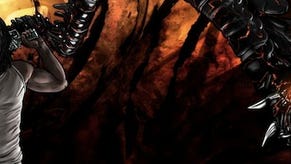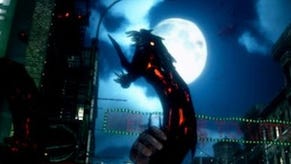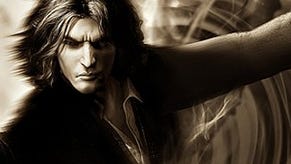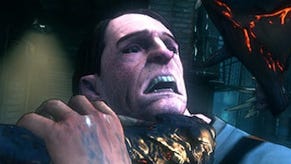Shadow warrior: playing with light in The Darkness II
We discuss how pigs were harmed in the making of the game, the difficulties of light-based game mechanics, and how relationships matter in the finalé of our chat with Seth Olshfski, producer on The Darkness II.
"People were like, ‘How are people gonna know that the light is bad?’ I was like, ‘Because it’s called the f**king Darkness."
Get the first part of Brenna's chat with Seth here.
Fans of the original game were already suspicious by the news that Starbreeze wouldn't be behind the sequel, and the new player up to bat didn't fill them with confidence. The developer's last notable project was the underwhelming Dark Sector, followed by stints jobbing on games celebrated under other studio's banners, like BioShock and Homefront. Producer Seth Olshfski had no doubts.
"Digital Extremes is so good at gameplay feel, at moment-to-moment gameplay," he told VG247.
"Like mapping the buttons to the places the guns are on the screen, so that you just get it, and then you feel like a complete bad ass. 'Cause you're shooting dudes and cuttin' 'em up, and you're like 'I'm awesome'.
"If you look at a still image of the game it does look like a comic panel, but it doesn't tell you a lot about how it feels to play it. When you look at videos it's a little better. You have to play it to understand how amazing they are at doing that."
For Digital Extremes, the transition back from odd-jobber to lead studio was made easier by existing relationships with 2K.
"It was pretty easy 'cause it was 2K for BioShock 2's multiplayer, and that was my project as well; I produced BioShock 2 and this," Olshfski said.
"So I knew the guys, we knew their strengths and weaknesses, they knew how to talk to 2K - that was important - and so all of those kind of operational adjustable things were already out of the way. Work on the game had started before [BioShock 2 wrapped] - they were going in parallel through much of both of their life cycles.
"[I could] kind of make sure that there was nothing that they had to think about other than how to make the game great. And once they got to that point, where that was the only thing that really mattered, then they could really make it shine."
Olshfski described 2K as a really "hands-on" publisher.
"I was in dev all the time. I was flying up all the time, in and out, working with Paul [Jenkins, lead writer]. Paul doesn't work for Digital Extremes - he's another party, so we had to all coalesce together. It was the right time, it was the right environment, and it was the right support for them to go out on their own," he said.
2K's confidence was echoed by comics publisher Top Cow.
"The way that they describe it - Matt Hawkins is always the one who takes this question; I've been in so many panels with them, and somebody always asks 'Matt and Mark, how much control did you have over this?' - they say that the control they want is in picking the right partner.
"They feel that they picked the right partner in 2K. And then we at 2K just keep spinning it back to them. I'm always the guy who has to present it to them. Every time I'm just sorta like, 'I hope this goes okay, we think it's cool.'"
Olshfski found it "stress-inducing," but Top Cow showed nothing but enthusiasm and has itself actively promoted the game. Thankfully, fans of the franchise have ben equally receptive so far.
"There's so many fans of The Darkness, there's so many fans of Top Cow, that we needed to make something that they would go 'that feels right, that's the right thing.' So it's one of the things we wanted as a guiding force, sort of," the producer noted.
"The comic folks really respect the art style, we've had really glowing reviews from all the comic cons we've gone to about the art style. they really love Marc and everyone at Top Cow, and when they watch the Top Cow guys love the game, it makes them love the game. I honestly haven't heard any of the comic folks bitching about it."
It probably helps that Digital Extremes' creative director, Sheldon Carter, is a massive fan himself.
"Sheldon Carter had been a collector of all of The Darkness comic books from the first Darkness comic book that came out in 1995. He has #5 through current [issues]," Olshfski revealed.
"At one point in time he really needed a little bit of help to make rent, and sold #1, #2, #3 and #4. He said that in front of Marc, so I think that after we ship I think that Marc's gonna sneak him #1, #2, #3 and #4, because they have a couple left. That is how much of a Darkness fan he is. All of us really love the comic, so we're really wanting to make sure that we were respectful of what was done in that world."
Digital extremes did receive negative feedback as they toured the unfinished game around comic conventions, but not from comic fans; gamers responded badly to the initial control scheme.
"We had problems with the left bumper. In early demos, the grabbing demon arm would fly out and pick things up when you released the bumper. It made people feel like they had to hold the bumper in and be like 'why isn't it working!' 'cause it only worked on release," Olshfski remembered.
"We ended up going to a show where we burnt out half of the controllers - the left bumper broke, because people were like, 'Why isn't it working? Everything felt good except the grabbing arm.' So we changed it to grab on tap instead of grab on release, which now everybody's happy with."
If broken controllers were all the problems the team had faced, they'd be laughing; instead, they spent a lot of time wrestling with headaches brough on by the game's harmful light mechanic. Olshfski said Digital extremes' proprietary engine, Evolution, underwent "insane" changes to make The Darkness II work.
"You can see that there's light, but it doesn't block everything behind it. it doesn't really get in the way. At the same time, you can tell, where it's dangerous to be and where it's safe to be because it's dark. And that was incredibly hard," he said.
"There's a light there, and then when you slash it, the light's off - but the light illuminates everything that's walking underneath it while it's there. That is really difficult for engines. We also have enemies that have shoulder-mounted light cannons, and they come into the place and they start shining the light on you - and I'm like, 'I hate this guy, I hate this guy completely'. There can be like five enemies in a room, of all the most difficult types; I always shoot the light guy first, because he's horrible. That light that he shines at you casts long shadows on everything, that move when he moves around. That's something that no engine does but this one.
"They had to code from the foundation up a lot of very specific stuff to make this art style and this gameplay works."
Designers also had to rethink many of their habitual tropes to cope with the reversal of themes.
"Level designers always put a bright light on the door that you're supposed to go through and no light on the door you're not supposed to go through, so players go 'I wonder where I'll go? I'll run towards the light'. We have exactly the opposite. 'I wonder where I'll go?' You have to run away from the light," Olshfski said.
"So we had to do some really screwed up things from a level design and an engine perspective to un-train players who are trained from movies and television and video games that light is good, because in this game light is evil."
"We had to do some really screwed up things from a level design and an engine perspective to un-train players who are trained from movies and television and video games that light is good, because in this game light is evil."
The team spent a lot of time tweaking the effect of light so as to signal clearly to the player that they should get out of the way, including "iteration after iteration" of the sizzling sound effect, which was created from multiple recordings of bacon frying and cats hissing, among other samples.
"All of the other sounds in the world sound a little like you're underwater [when you're in the light]; they did a treatment to make it sound like you have water in your ears - so maybe like your ears haven't popped after landing from flying in an airplane. Audio, visual, movement - everything is bad when you're in the light and you want to get out of the light," Olshfski said.
"So we don't actually have a tutorial moment for harmful light, and that was controversial - controversial! - inside the team. People were like, 'How are people gonna know that the light is bad?' I was like, 'Because it's called the f**king Darkness.'
"And that was a fight, but in the end we made the light so strong that you know it's bad. No one has to tell you it's bad. We don't need an on-screen prompt saying 'you should walk away from the light'. Because you just figure it out. And that was in service of story, what we were aiming for."
The Darkness II is out now on PC, PlayStation 3 and Xbox 360.




















